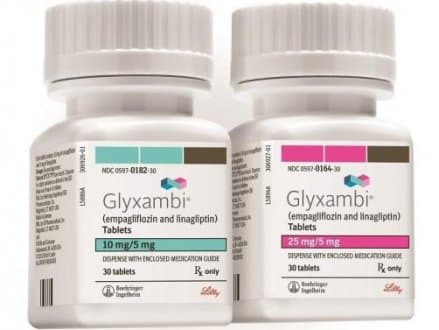This guide explains how glyxambi fits into type 2 diabetes care, including what it does, who may benefit, and how it is typically used. You will also find safety considerations, cost factors, and practical tips to support informed conversations with your clinician.
Key Takeaways
- Dual action benefit: SGLT2 plus DPP-4 effects in one tablet.
- Dosing is once daily; consistency and hydration habits matter.
- Common adverse effects involve genital/urinary infections and dehydration.
- Coverage, discounts, and alternatives can help manage therapy costs.
What Is glyxambi?
Glyxambi combines empagliflozin (an SGLT2 inhibitor) and linagliptin (a DPP-4 inhibitor). This dual mechanism helps the kidneys remove extra glucose in urine and supports incretin hormones that regulate insulin and glucagon. The result is a complementary effect on blood glucose with one daily tablet.
Official prescribing references describe indications, dosing ranges, and safety warnings for this fixed-dose combination. For labeled uses and important cautions, see the FDA’s prescribing information resources for approved diabetes medicines. For product specifics and strength listings, see Glyxambi, which outlines how this combination is packaged for patients.
How It Works: Dual Mechanisms Explained
This medicine pairs two proven approaches. Empagliflozin reduces renal glucose reabsorption, increasing urinary glucose excretion. Linagliptin enhances incretin activity, helping the pancreas better match insulin and glucagon release to meals. Together, these actions can help smooth daily glucose patterns.
Because the components act differently, clinicians may consider it for patients who need more than lifestyle changes or a single agent. For a deeper look at the SGLT2 class effects—glucose, weight, and kidney considerations—review this primer on SGLT2 Inhibitors Drugs for background and class comparisons.
SGLT2 Inhibition
SGLT2 inhibition targets glucose handling in the kidney’s proximal tubule. By lowering the renal threshold for glucose, more sugar exits through urine, which can reduce fasting and post-meal levels. This pathway is insulin-independent, so it can provide benefit even when beta-cell function is reduced. Class effects may include mild diuresis, a small blood pressure drop, and modest weight changes. These effects can be helpful for many adults with type 2 diabetes. However, they may also increase dehydration risk in hot weather, during illness, or with low fluid intake.
DPP-4 Inhibition
DPP-4 inhibition preserves endogenous incretins, such as GLP-1 and GIP. This helps the pancreas release insulin more precisely in response to meals and reduces excess glucagon. The effect is generally weight-neutral and has a low risk of hypoglycemia when used without insulin or sulfonylureas. In a fixed-dose tablet, this mechanism complements SGLT2 effects, which act outside the pancreas.
Indications and Patient Selection
Approved glyxambi uses focus on adults with type 2 diabetes who need additional glycemic control alongside diet and exercise. This fixed-dose tablet may be considered when single-agent therapy is not enough or when combining agents improves daily adherence. Clinicians often individualize choices based on comorbidities, risk of adverse effects, and personal preferences.
People with established cardiovascular disease or kidney concerns may be evaluated for SGLT2-containing regimens due to class findings. Decisions should reflect individual health histories and lab trends. For broader context on where this therapy fits within type 2 treatment strategies, see the category overview Type 2 Diabetes for condition-focused articles and updates.
Dosage and Administration
Typical glyxambi dosage is once daily, taken at the same time each day. Tablets can be taken with or without food. Maintaining adequate hydration is important, because mild diuresis can occur with SGLT2-based therapies. Clinicians may adjust therapy based on response, tolerability, and kidney function.
Do not change your dose without medical guidance. For practical context on how diabetes medicines are layered or sequenced, this overview of Common Diabetes Medications explains mechanisms and common combinations.
Tablet Strengths and Titration
Two fixed-dose strengths are commonly used. The 10 mg/5 mg tablet is often used when clinicians seek a lower starting combination. The higher strength, 25 mg/5 mg, may be considered if additional glucose lowering is needed and the regimen is well tolerated. The exact choice depends on goals, labs, and coexisting conditions.
Many patients are familiar with the individual components from other products. For the empagliflozin-only option comparison, see Jardiance to understand SGLT2 dosing across brands. For the linagliptin-only comparator, see Tradjenta, which shows how the DPP-4 component is used independently.
When referring to packaging or medical charts, you may see shorthand like glyxambi 10/5 to describe tablet strength. Your prescriber will choose a strength based on your response and lab results over time.
Side Effects and Safety Profile
Common glyxambi side effects include genital yeast infections, urinary tract infections, and increased urination. Dizziness or low blood pressure can occur, especially in hot weather, with vomiting or diarrhea, or if diuretics are used. Rare but serious risks include ketoacidosis and a severe genital infection called Fournier’s gangrene.
These risks are discussed in safety communications and prescribing references. For details on ketoacidosis warnings with SGLT2 drugs, see the FDA’s communication on diabetic ketoacidosis. For rare genital infections associated with the class, review the FDA’s notice on serious genital infections. For patient-friendly overviews of the components, see MedlinePlus on empagliflozin and linagliptin.
For additional safety-related reading across therapies, browse the hub Diabetes Articles to see educational pieces on risks, monitoring, and prevention.
Weight and Cardiometabolic Effects
Reports of glyxambi weight loss reflect the SGLT2 component’s effect on urinary glucose excretion. This mechanism can reduce calories retained, leading to modest weight changes for some. The DPP-4 component is generally weight-neutral, so the net effect is usually small to moderate.
Weight response varies by diet, hydration, and other medicines. It is not a weight-loss drug, and results differ across individuals. For comparison with another SGLT2 option that may influence body weight, see Invokana, which provides a single-agent benchmark for class expectations.
Cost, Access, and Value
Patients often ask, why is glyxambi so expensive. Several factors drive branded combination costs, including intellectual property, clinical development, supply chain, and insurance formulary placement. Copays vary widely depending on coverage tier, deductibles, and benefit design. Pharmacoeconomic value depends on your specific goals and risks.
Comparing alternatives within the same therapeutic classes can help. Reviewing multiple products may reveal lower copays or better coverage. To explore other agents used in diabetes care, the Diabetes Products section groups related therapies for easier review with your care team.
Savings and Support Options
If cost is a barrier, ask about a glyxambi coupon or savings support. Manufacturer programs, pharmacy discount cards, and insurer exceptions may reduce out-of-pocket costs for eligible patients. You can also ask your clinician about therapeutic substitutions if your plan prefers a different brand.
Some patients qualify for a patient assistance program through the manufacturer or nonprofit organizations. These programs often require income verification and documentation. Your prescriber’s office or a pharmacist can help check eligibility and complete forms, which can streamline access.
Timing, Meals, and Practical Use
Tablets can be taken with or without food, so focus on consistent timing. Many patients choose morning use to align with daily routines and hydration. Aim to drink enough fluids, especially during exercise, hot weather, or illness. If you feel lightheaded, pause and hydrate, then contact a clinician for advice.
A travel routine helps too. Keep medicines in original packaging, and bring a current medication list. If you take other agents like metformin combinations, see Synjardy for examples of pairing metformin with an SGLT2 inhibitor. For another SGLT2 reference on dosing routines, see Dapagliflozin to compare once-daily timing across brands.
Compare and Related Options
Therapy choice is individualized. Some patients prefer a single-agent SGLT2 or DPP-4 inhibitor, while others need combinations. For SGLT2-only options often considered in type 2 diabetes, see Farxiga or Steglatro for comparable mechanisms. If your clinician suggests pairing an SGLT2 with another class, Qtern shows a different fixed-dose combination approach.
When DPP-4 therapy is preferred with metformin formulations, see Janumet XR or Invokamet to understand how combination tablets are structured. These pages help you compare mechanisms and pill burdens across regimens so you can discuss options with your provider.
Recap
This dual-mechanism tablet offers once-daily convenience with complementary glucose-lowering effects. Safety monitoring, hydration, and consistent dosing habits matter. If cost or coverage is challenging, explore assistance pathways or alternatives within the same classes. Align choices with your goals, lab results, and medical history to support steady, long-term management.
Note: This content is for informational purposes only and is not a substitute for professional medical advice.



